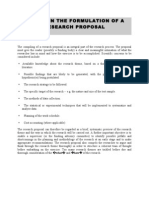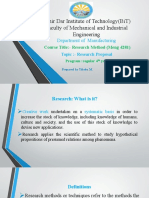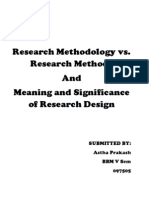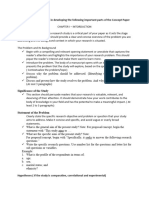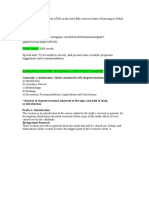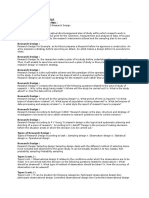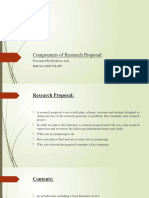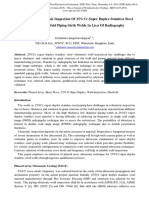0 ratings0% found this document useful (0 votes)
6 viewsChapter 4
Chapter 4
Uploaded by
gebesisayResearch method ch4
Copyright:
© All Rights Reserved
Available Formats
Download as DOCX, PDF, TXT or read online from Scribd
Chapter 4
Chapter 4
Uploaded by
gebesisay0 ratings0% found this document useful (0 votes)
6 views26 pagesResearch method ch4
Copyright
© © All Rights Reserved
Available Formats
DOCX, PDF, TXT or read online from Scribd
Share this document
Did you find this document useful?
Is this content inappropriate?
Research method ch4
Copyright:
© All Rights Reserved
Available Formats
Download as DOCX, PDF, TXT or read online from Scribd
Download as docx, pdf, or txt
0 ratings0% found this document useful (0 votes)
6 views26 pagesChapter 4
Chapter 4
Uploaded by
gebesisayResearch method ch4
Copyright:
© All Rights Reserved
Available Formats
Download as DOCX, PDF, TXT or read online from Scribd
Download as docx, pdf, or txt
You are on page 1of 26
UNIT- 4
THE RESEARCH DESIGN
Concept of research design
Research design is the important step in any research
work.
After the researcher has formulated the research
problem, the research design must be developed.
A research design is a master plan specifying the
methods and procedures for collecting and analyzing the
needed information.
It is a framework of the research plan of action.
It constitutes the blueprint for the collection, measuring
and analysis of data.
It is the plan, structure and strategy of investigation
conceived so as to obtain answers to research questions.
Need for research design
Research design is needed because:
It facilitates the smooth sailing of the research
operation.
It makes research project as efficient as possible and
help to yield maximum information with minimum
expenditure, time and effort.
It helps the researcher to organize his ideas in a form
where by it will be possible for him to look for flaws
and inadequacies.
It will be given to others for their comment and
critical evaluation.
In absence of such course of action, it will be difficult
for the critics to provide comprehensive review of
the proposed study.
Important features of research design
The design is an activity-and –time based plan.
The design is always based on the research
question.
The design guides the selection of sources and
types of information.
The design is a framework for specifying the
relationships among the study’s variables.
The design outlines procedure for every research
activity.
Essentials of a good research design
It is a plan that specifies the objectives of the
study and the hypotheses to be tested.
It is an outline that specifies the sources and
types of information relevant to the research
questions.
It is a blueprint specifying the methods to be
adopted for gathering and analyzing the data.
It is a scheme defining the domain of
generalizability, i.e., whether the obtained
information can be generalized to a larger
population or to different situations.
Classification of research design (typology of RD)
Preparation of the research design/plan
Planning involves deciding things in advance.
Accordingly the preparation of a research plan involves a
careful considerations of the following questions and
making appropriate decision on them.
What the study is about?
Why is the made?
What is its scope?
What are the objectives of the study?
What are the propositions to be tested?
What are the major concepts to be defined
operationally?
On the basis of what criteria or measurements, the
operational definitions to be made?
When or in what place the study will be conducted?
What is the reference period of the study?
What is the typology of the design?
What kinds of data are needed?
What are the sources of data?
What is the universe from which the sample as to
be drawn?
What is the sample size?
What sampling techniques to be used?
What methods are to be adopted for collecting data?
What tools are to be used for collecting data?
How the data are to be processed?
What techniques of analysis are to be adopted?
What is the significance of the study?
To what target audience the reporting of the
findings is meant?
What is the type of report to be prepared?
What is the time period required for each stage of
research work?
What is the time limit within which the whole
work should be completed?
What is the cost involved?
The contents of a research plan /proposal
After making decisions on the above questions, a
formal research plan/proposal is drafted,
incorporating those decisions.
The format may vary depending on the purpose
for which the study is undertaken, but, in general,
the research plan/proposal of a research
student/academician may cover the following
essential sections.
Title
Research proposal title should demarcate the
main focus/ or theme of the proposed study.
The title should accurately reflect the scope and
content of the study.
In addition, it should be concise, simple and
catchy in not more than 20 words.
It should be concise and descriptive.
Abstract
It is a brief summary of approximately 300 words
(more or less).
It should include the research objective, the
rationale for the study, the hypothesis (if any),
methodology of the study and expected output.
It should also be separate page, one paragraph,
single space and italic in format.
Background of the Study (Justification of the
Study)
Rationale or reason or motive for conducting the
research.
Background of the Organization (Optional)
Introducing the organization where the research
will be undertaken.
Statement of the Problem
Under it, why and how the problem is selected
are stated.
The research problem should be clearly defined,
pointing out its core nature and its importance.
The issue relating to the problem may also be
stated.
This statement gives direction to the research
process.
Objectives of the study (State what your research
hopes to accomplish) or (Here you can write about the aims and
goals of the research and what will you achieve generally and
specifically)
– General Objectives
– Specific Objectives
(Or)
Research Questions (State what your research hopes
to get answers to the questions)
– General Questions
– Specific Questions
Conceptual model
This section is the heart of the research plan.
This is where the researcher formulates and
develops the structure of relationships among the
variables he is investigating.
The logical connection of the variables is
delineated.
The assumptions, and propositions used to
develop the explanatory framework are included.
The entire research project rests upon the
theoretical framework.
Research Hypotheses (If applicable)
These are logically deducted from the theoretical
frame work above.
These refer to the anticipated outcome or
possible answers to the research questions.
They should be conceptually clear, specific and
simple.
The sources of their formulation may be
indicated.
The specific hypotheses to be tested are stated.
Operational definition of concepts
The major concepts used in the title of the study,
its objectives, the investigative questions and the
hypotheses should be identified.
Each of them should be defined in operational
terms relevant to the measurement criteria or
operations.
Significance or Importance or Need for the Study
It is important to point out the relevance and
significance of the investigation.
What would be the value of the findings of the
study for policy formulation, theory or practice?
Can the findings contribute to the enrichment of
theory and/or to the solution of some practical
problems?
A careful statement of the value of the study and
the possible applications of its finding helps to
justify its importance and social relevance.
Scope of the Study
It provides the boundary or framework.
The dimensions of the study in terms of the
geographical area covered, the designation of the
population being studied, and the level of
generality of the study are specified.
Organization of the Paper
It is a plan for how many and what chapters will
be contained in the paper.
Review of the previous studies
An empirical literature review summarizes the
nature of studies which have been already done
in the field of proposed research.
It will bring out the gaps and arguments in the
existing research that support the need of the
proposed research, and how the proposed
research will fill those gaps.
Methodology
This section gives the details of how the researcher will
carry out the proposed research.
Typology of research design ( Give your reason)
Data type
- Qualitative
- Quantitative
Data Source
- Primary (specify)
- Secondary (specify)
Data collection instruments (specify clearly and why)
Sample design and sample size (give your reasons)
Data processing procedures
Data analysis techniques
Time Schedule
How much time it will take to carry out the
research, starting from proposal preparation to
final submission of the final paper.
Budget Schedule
It is a plan for presenting how much cost will be
incurred to carry out the research.
References/Bibliography
Make sure these follow a recognized format, and
do so consistently.
References: are lists of
literature,which have been
cited in the text of a document.
Bibliography: includes also items, which are not
cited but are relevant to the document.
You might also like
- Methods of Research: Simple, Short, And Straightforward Way Of Learning Methods Of ResearchFrom EverandMethods of Research: Simple, Short, And Straightforward Way Of Learning Methods Of ResearchRating: 4.5 out of 5 stars4.5/5 (6)
- Research Proposal For MphilDocument3 pagesResearch Proposal For MphilHassan Raza100% (5)
- Flicker Rate TV Weapon Experiment On MonkeysDocument4 pagesFlicker Rate TV Weapon Experiment On Monkeysmarko2222No ratings yet
- Blending ProblemDocument6 pagesBlending ProblemMohammad Nazmul IslamNo ratings yet
- Stages in The Formulation of A Research ProposalDocument4 pagesStages in The Formulation of A Research Proposalbasit_abcNo ratings yet
- Assignment I Question 1 Marking GuideDocument3 pagesAssignment I Question 1 Marking GuideLuke KandiyawoNo ratings yet
- Media Research Unit 3Document22 pagesMedia Research Unit 3DragenvoygerNo ratings yet
- Dba Module 5 Research Design2Document52 pagesDba Module 5 Research Design2felix majaniNo ratings yet
- Research DesignDocument6 pagesResearch Designashwini rotheNo ratings yet
- Research MethodDocument26 pagesResearch Methodabrham haileyesusNo ratings yet
- Research Methodology vs. Research Methods and Meaning and Significance of Research DesignDocument5 pagesResearch Methodology vs. Research Methods and Meaning and Significance of Research DesignMahima SharanNo ratings yet
- Preparation of SynopsisDocument21 pagesPreparation of SynopsisVijay Kumar SinghNo ratings yet
- Parts of A Research ReportDocument8 pagesParts of A Research ReportjonnNo ratings yet
- Research M Eco CH 4Document27 pagesResearch M Eco CH 4muzeferuzNo ratings yet
- Revised Components of A Research ProposalDocument5 pagesRevised Components of A Research ProposalBedri M AhmeduNo ratings yet
- Ecahandouts ThesisOutlineDocument6 pagesEcahandouts ThesisOutlineVirg Sci-hiNo ratings yet
- Title of The Research Project: Questions or Broader Issues Motivating The Research. Words Used inDocument4 pagesTitle of The Research Project: Questions or Broader Issues Motivating The Research. Words Used inMelanie Pad-ayNo ratings yet
- Dissertation Proposal (Updated)Document6 pagesDissertation Proposal (Updated)VIRTUAL UNIVERSITYNo ratings yet
- Research ProposalDocument7 pagesResearch ProposalMahendra ChhetriNo ratings yet
- Research DesignDocument19 pagesResearch DesignSHIVANGI ARORANo ratings yet
- Guide For You To Consider in Developing The Following Important Parts of The Concept PaperDocument5 pagesGuide For You To Consider in Developing The Following Important Parts of The Concept Paperjesmar melodiasNo ratings yet
- Generally, A Dissertation / Thesis Contains Five (5) Chapters/sections, Which AreDocument6 pagesGenerally, A Dissertation / Thesis Contains Five (5) Chapters/sections, Which AreJaleel SheikhaNo ratings yet
- Developing Research ProposalDocument8 pagesDeveloping Research Proposalsamuel seifuNo ratings yet
- Writing Strategies and Ethical ConsiderationsDocument7 pagesWriting Strategies and Ethical Considerationsnazlah.alrobiah93No ratings yet
- Research: Proposal: Prof. Dr. Md. Ghulam Murtaza Khulna University Khulna, BangladeshDocument31 pagesResearch: Proposal: Prof. Dr. Md. Ghulam Murtaza Khulna University Khulna, BangladeshSaiful Hadi Mastor100% (1)
- The Research ProposalDocument25 pagesThe Research ProposalMarkos DanielNo ratings yet
- Research - ProposalDocument31 pagesResearch - ProposalEmmanuel Selase Asamoah100% (1)
- Chapter Three Developing A Research Proposal: 3.1. The Purpose of ProposalsDocument4 pagesChapter Three Developing A Research Proposal: 3.1. The Purpose of ProposalsBereket Desalegn100% (1)
- Templates For Undergraduate ResearchDocument26 pagesTemplates For Undergraduate ResearchWynnie RondonNo ratings yet
- Definition of A Research Project ProposalDocument11 pagesDefinition of A Research Project ProposalAbu BasharNo ratings yet
- The Seven Steps of The Research ProcessDocument4 pagesThe Seven Steps of The Research ProcessAli HaiderNo ratings yet
- UG Physiology Sem6 DSE4TDocument37 pagesUG Physiology Sem6 DSE4TBiksham JimmidiNo ratings yet
- Project Guidelines For M. ComDocument35 pagesProject Guidelines For M. ComMuhammad Ayyaz Iftikhar0% (1)
- Research Methodology Lecture - 6Document14 pagesResearch Methodology Lecture - 6Tasin Safwath ChowdhuryNo ratings yet
- RESEARCH PROCESS - Research Execution - 29th October 2024Document12 pagesRESEARCH PROCESS - Research Execution - 29th October 2024shariqahmad866No ratings yet
- How To Write A Good Research - ProposalDocument31 pagesHow To Write A Good Research - ProposalPM 2014 1st year summer studentsNo ratings yet
- Research-Design :3Document13 pagesResearch-Design :3owoo7408No ratings yet
- Benue State University, MakurdiDocument6 pagesBenue State University, MakurdiABRAHAM UJAHNo ratings yet
- Steps of Research ProcessDocument6 pagesSteps of Research ProcessJasreaNo ratings yet
- RM-2 (RPC)Document18 pagesRM-2 (RPC)deepak malikNo ratings yet
- Practical Research 2 Guidelines For Writing and Presenting The Research ProposalDocument4 pagesPractical Research 2 Guidelines For Writing and Presenting The Research Proposalro.abirinNo ratings yet
- Research DesignDocument27 pagesResearch DesignMinaxi DakaNo ratings yet
- Research DesignDocument20 pagesResearch DesignShubham SinghNo ratings yet
- Research MethodologyDocument5 pagesResearch MethodologyAkash AgarwallaNo ratings yet
- Purpose of Research ProposalDocument4 pagesPurpose of Research ProposalKashif19869802No ratings yet
- Research - ProposalDocument31 pagesResearch - ProposalGarvit DhingraNo ratings yet
- EDOL 630 Week 5 PPT Spring IGb 2022Document25 pagesEDOL 630 Week 5 PPT Spring IGb 2022Karanja Wa Njuguna CyclistNo ratings yet
- Ch4 ResearchDocument18 pagesCh4 ResearchMuste HanaNo ratings yet
- Mb0050 SLM Unit03Document22 pagesMb0050 SLM Unit03Jignesh PatelNo ratings yet
- PGCRSM-01-BLOCK-03 Research Design ExperimentalDocument29 pagesPGCRSM-01-BLOCK-03 Research Design ExperimentalVijilan Parayil VijayanNo ratings yet
- Resaearch DesignDocument8 pagesResaearch DesignFerl ClariteNo ratings yet
- Research Process - PR RESEARCHDocument4 pagesResearch Process - PR RESEARCHPratik SahaNo ratings yet
- Writing Winning Research Proposal 28022019Document83 pagesWriting Winning Research Proposal 28022019gedle100% (1)
- 5 - Writing A Resarch ProposalDocument12 pages5 - Writing A Resarch ProposalawokegoshiNo ratings yet
- Sample Research Thesis WritingDocument43 pagesSample Research Thesis Writingsubs143100% (2)
- Leacture NoteDocument82 pagesLeacture NoteYN JohnNo ratings yet
- Chapter 2Document26 pagesChapter 2diyarmynajiNo ratings yet
- Research Proposal Assignment 08Document3 pagesResearch Proposal Assignment 08sahhhhhhhNo ratings yet
- Research ppt3Document18 pagesResearch ppt3qandeelNo ratings yet
- Research Proposal a Simplified Step-by-Step Guide - Revised EditionFrom EverandResearch Proposal a Simplified Step-by-Step Guide - Revised EditionNo ratings yet
- Holt Pre Algebra Homework and Practice Workbook PDFDocument8 pagesHolt Pre Algebra Homework and Practice Workbook PDFcan3z5gx100% (1)
- 16.4.7 Lab - Configure Network Devices With SSHDocument6 pages16.4.7 Lab - Configure Network Devices With SSHCRISTIAN DAVID VIASUS VEGANo ratings yet
- 5 PDFDocument20 pages5 PDFBhojpuri DHAMAALNo ratings yet
- LC Meter With The 89C2051Document8 pagesLC Meter With The 89C2051Manch PssNo ratings yet
- SRS Nptel PDFDocument9 pagesSRS Nptel PDFAkriti SinghNo ratings yet
- Lista Comandos WindowsDocument6 pagesLista Comandos Windowsdiogenes torresNo ratings yet
- Presentacionde DubrovnicDocument318 pagesPresentacionde DubrovnicpcfloridoNo ratings yet
- Nrusso Ccie Ccde Evolving Tech 1july2018 PDFDocument173 pagesNrusso Ccie Ccde Evolving Tech 1july2018 PDFThiago SantosNo ratings yet
- PETRO TCS 682 Series Piston Meter Operations ManualDocument42 pagesPETRO TCS 682 Series Piston Meter Operations Manualpaulm3565No ratings yet
- Apx Next Data SheetDocument8 pagesApx Next Data SheetRodriguez RamonNo ratings yet
- Super Duplex Con PADocument8 pagesSuper Duplex Con PAanon_447449056No ratings yet
- Findhu Glen 1Document3 pagesFindhu Glen 1annabelledarcy247No ratings yet
- Smart View Excel Memory UsageDocument4 pagesSmart View Excel Memory UsageRajendran SureshNo ratings yet
- Ga HPH Bypass ValveDocument87 pagesGa HPH Bypass ValveshubhamNo ratings yet
- CFA Level1 2017 Mock Exam PDFDocument75 pagesCFA Level1 2017 Mock Exam PDFHéctor GarcíaNo ratings yet
- HGM-560 Oil Cooler (Secondary Oil Circuit-130 Plates)Document3 pagesHGM-560 Oil Cooler (Secondary Oil Circuit-130 Plates)cdiscuaNo ratings yet
- Part - I: Chapter 2 - Piping ComponentsDocument8 pagesPart - I: Chapter 2 - Piping ComponentsAshish PatelNo ratings yet
- Astm 531Document5 pagesAstm 531JOSEPH REFUERZONo ratings yet
- The Hull CellDocument25 pagesThe Hull CellCarlos Alberto Soto Ramirez67% (3)
- Math 10 Week 2Document10 pagesMath 10 Week 2Myla MillapreNo ratings yet
- MR Scanner BRDocument6 pagesMR Scanner BRlaskireNo ratings yet
- Software Engineering Slot: F2: School of Computer Science & EngineeringDocument42 pagesSoftware Engineering Slot: F2: School of Computer Science & Engineeringharshit shrivastavaNo ratings yet
- Worksheet On Algebraic FractionsDocument21 pagesWorksheet On Algebraic Fractionsmathsman9100% (1)
- 636408208709126602-SVXT Data Sheet PDFDocument11 pages636408208709126602-SVXT Data Sheet PDFIrinafan100% (1)
- Differential Equations PDFDocument20 pagesDifferential Equations PDFAlaviNo ratings yet
- Q2 Summative G10Document2 pagesQ2 Summative G10Lujille AnneNo ratings yet
- Lecture 22 - Electronics Cooling MechanismsDocument20 pagesLecture 22 - Electronics Cooling MechanismsSridhar RaoNo ratings yet
- MANUAL v.1c: ContactDocument13 pagesMANUAL v.1c: ContactlucasNo ratings yet




